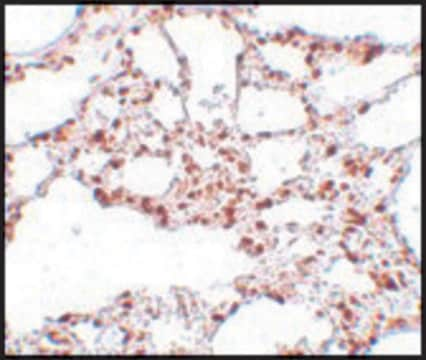推荐产品
生物来源
rabbit
质量水平
抗体形式
affinity isolated antibody
抗体产品类型
primary antibodies
克隆
polyclonal
纯化方式
affinity chromatography
种属反应性
mouse
技术
immunoprecipitation (IP): suitable
western blot: suitable
NCBI登记号
UniProt登记号
运输
wet ice
靶向翻译后修饰
unmodified
一般描述
锌指和SCAN结构域含蛋白4C(Zscan4c,也称为Gm397)基因(Gene ID: 245109)编码锌指和SCAN结构域含蛋白4C(UniProt: Q80VJ6),该基因在小鼠中表达。Zscan4是一种胚胎干细胞(ES细胞)特异性的转录因子,对于调控多能性、促进端粒延长以及抵抗细胞衰老至关重要。它在小鼠二细胞胚胎的合子基因组激活期间表达,并通过稳定微卫星重复DNA的B-DNA构象来保护胚胎免受DNA损伤。Zscan4能够结合CA/TG微卫星重复序列中的TGCACAC基序,调节端粒延长以维持基因组稳定性,并在未分化的ES细胞中激活自发的端粒姐妹染色单体交换(T-SCE)。在发育过程中或在小鼠胚胎干细胞(mESC)中,Zscan4功能障碍会导致着床失败、端粒维持缺陷以及染色体重排。(参考文献:Srinivasan, R., et al., (2020), Sci. Adv., 6, eaaz9115)
免疫原
KLH偶联的线性肽,对应于来自小鼠Zscan4蛋白C末端一半的16个氨基酸。该免疫原序列在Zscan4家族蛋白(Zscan4b、Zscan4C、Zscan4d和Zscan4f)之间是保守的。
应用
抗Zscan4抗体(货号07-579)是一种兔多克隆抗体,可检测Zscan4,经过测试可用于蛋白质印迹法。
研究子类别
转录因子
转录因子
研究类别
表观遗传学&核功能
表观遗传学&核功能
质量
通过蛋白质印迹在小鼠胚胎干细胞(mESC)裂解液中进行了评估。 蛋白印迹分析:该抗体稀释1:2,000时可在小鼠胚胎干细胞(mESC)裂解液中检测到Zscan4。
目标描述
目标分子量:观察值为~60 kDa;计算值为60.0 kDa。在一些裂解液中可能会观察到未表征的条带。
外形
亲和纯化
纯化的兔多克隆抗体,溶于含有0.1 M Tris-甘氨酸(pH 7.4)、150 mM NaCl和0.05%叠氮化钠的缓冲液中。
储存及稳定性
建议储存:+2°C至+8°C。
分析说明
对照
胚胎干细胞裂解物
胚胎干细胞裂解物
其他说明
浓度:请参考批次特异性浓缩物的分析证书。
免责声明
除非我们的产品目录或产品附带的其他公司文档另有说明,否则我们的产品仅供研究使用,不得用于任何其他目的,包括但不限于未经授权的商业用途、体外诊断用途、离体或体内治疗用途或任何类型的消费或应用于人类或动物。
未找到合适的产品?
试试我们的产品选型工具.
储存分类代码
12 - Non Combustible Liquids
WGK
WGK 1
闪点(°F)
Not applicable
闪点(°C)
Not applicable
Diego Rodriguez-Terrones et al.
EMBO reports, 21(1), e48354-e48354 (2019-12-19)
Pluripotent stem cells are thought of as a surrogate of early developmental stages that sustain the capacity to generate all cell types in the body, thereby constituting an invaluable tool to address the mechanisms underlying cellular plasticity. In the mouse
Ane Iturbide et al.
Nature structural & molecular biology, 28(6), 521-532 (2021-05-29)
Totipotent cells hold enormous potential for regenerative medicine. Thus, the development of cellular models recapitulating totipotent-like features is of paramount importance. Cells resembling the totipotent cells of early embryos arise spontaneously in mouse embryonic stem (ES) cell cultures. Such '2-cell-like-cells'
Diego Rodriguez-Terrones et al.
Nature genetics, 50(1), 106-119 (2017-12-20)
Unlike pluripotent cells, which generate only embryonic tissues, totipotent cells can generate a full organism, including extra-embryonic tissues. A rare population of cells resembling 2-cell-stage embryos arises in pluripotent embryonic stem (ES) cell cultures. These 2-cell-like cells display molecular features
Lei Yang et al.
EMBO reports, 21(9), e50054-e50054 (2020-07-28)
Cloned animals generated by somatic cell nuclear transfer (SCNT) have been reported for many years; however, SCNT is extremely inefficient, and zygotic genome activation (ZGA) is required for SCNT-mediated somatic cell reprogramming. To identify candidate factors that facilitate ZGA in
Zhijun Huang et al.
Science advances, 7(4) (2021-02-02)
5-Methylcytosine (5mC) oxidases, the ten-eleven translocation (TET) proteins, initiate DNA demethylation, but it is unclear how 5mC oxidation is regulated. We show that the protein SMCHD1 (structural maintenance of chromosomes flexible hinge domain containing 1) is found in complexes with
我们的科学家团队拥有各种研究领域经验,包括生命科学、材料科学、化学合成、色谱、分析及许多其他领域.
联系技术服务部门







